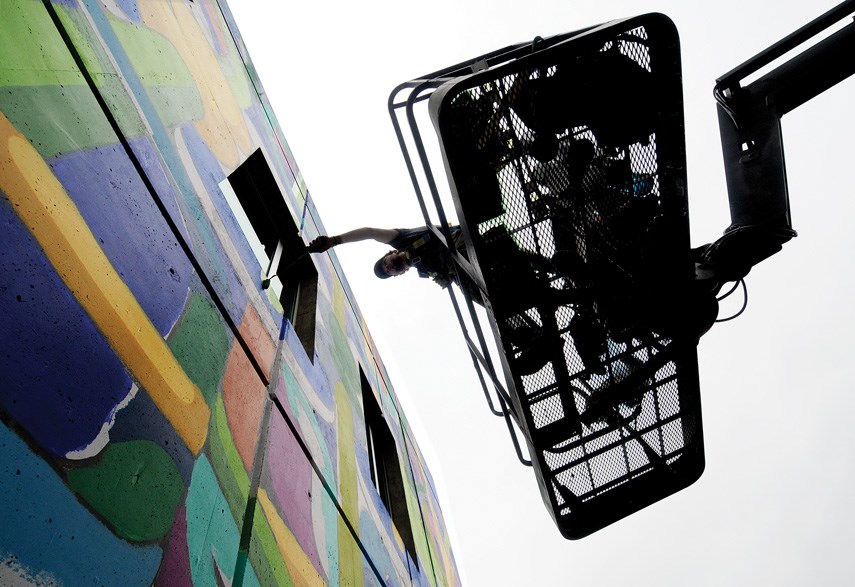Between a sky the colour of slate and a building the colour of the sky, a work of art is being born.
With slow, deliberate spins of a mini paint roller, artist Andrew Tavukciyan is bathing Capilano University’s Birch building in brightly coloured, geometric shapes.
“I don’t even know what it is, to be honest,” he says, leaning back on his crane and appraising the coils and bursts of pink, blue and green that are beginning to eclipse the shade of gravel-grey that dominates the campus like a one-party system.
To mark Capilano’s 50th anniversary, the university has recruited artists to transform nine walls on the North Vancouver campus with designs commemorating a half-century of bull sessions, cram sessions, pop quizzes and performances.
Community discussions had focused on making the university more vibrant and colourful, explains Capilano alumni and development director Scott Blythe.
It was meant figuratively, but the university decided to take the idea literally, quickly establishing a partnership with the Vancouver Mural Festival.
With $100,000 in donor funds at their disposal, the school put out a call for artists who could celebrate Capilano’s value while transforming it in the same fashion the Vancouver Mural Festival enlivened Vancouver’s Mount Pleasant neighbourhood.
“One of the things that we wanted to be careful of was to allow them to be true to that and make sure it’s also in line with our values as a community,” Blythe says of the artists.
The art could be “future focused” or it could be “nodding to the past,” Blythe adds.
“It’s a physical expression of the values that we see, the vibrancy that we see in our community, the colours, the brightness and the diversity.”
To colour between the lines, Capilano University rated artist submissions based partially on their connection to the school. A current or recent student would rate higher than someone who only had a tangential connection to the area, Blythe says.
For artist Brynn Staples, who had often noticed the overwhelming greyness while studying at Capilano’s IDEA School of Design, the call represented a chance to aid the morale of the demoralized.
Staples is preparing to festoon the building that houses the School of Design with a mural that celebrates connection.
The theme is appropriate, she says, given her connection with fellow Capilano University muralists Emily Huynh, Courtney Lamb and Ata Ojani,all of whom are preparing to enter their third year studying design and visual communication.
“We thought we could come up with something really cool together,” she says, noting the combination of Huynh’s geometric progressions, Lamb’s emphasis on tactile works and Ojani’s distinctive illustration style.
As Capilano students they’d all been inspired by the intermingling of form and substance, and “the bigger idea” lurking behind great works of art, she says.
They didn’t want to create something that would just be a pretty picture, she explains. They wanted meaning.
A stone’s throw from the Arbutus building, Tavukciyan is adding shading to the base colours, whistling as hip hop booms from his stereo.
His fingers are bright green, giving him an odd resemblance to Bruce Banner in the early stages of his transition to the Incredible Hulk.
“Everything is inspiration,” he says, explaining the necessity of incorporating the building’s windows into his design.
Interesting plants, architecture, and a catalogue of artistic formulae inform his graffiti-influenced work.
Graffiti art and street art mirror each other, he says.
“They go hand in hand,” he says. “One’s illegal, one’s not.”
Mural painting is an emerging field, Blythe says.
“It’s kind of transitioning from that graffiti to that legitimate art,” he says, adding that the goal is for the murals to endure.
“There is a life to these. We want to make sure that it’s not just pretty for a day.”
The public is set to get their first glimpse of the finished work Sept. 22 as part of CapFest.
“Nothing’s finished,” Tavukciyan says. And then he heads back up in his crane, ready to make his wall and his world a little less grey.



